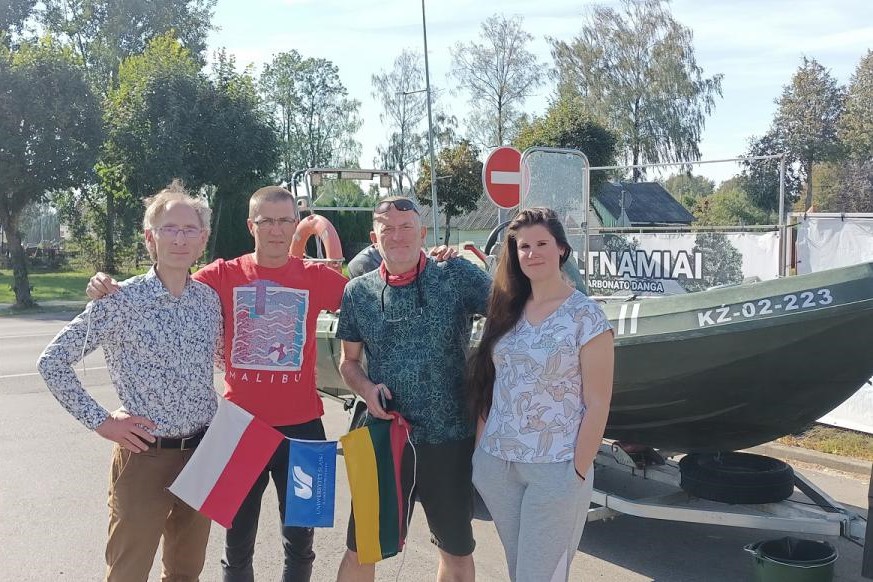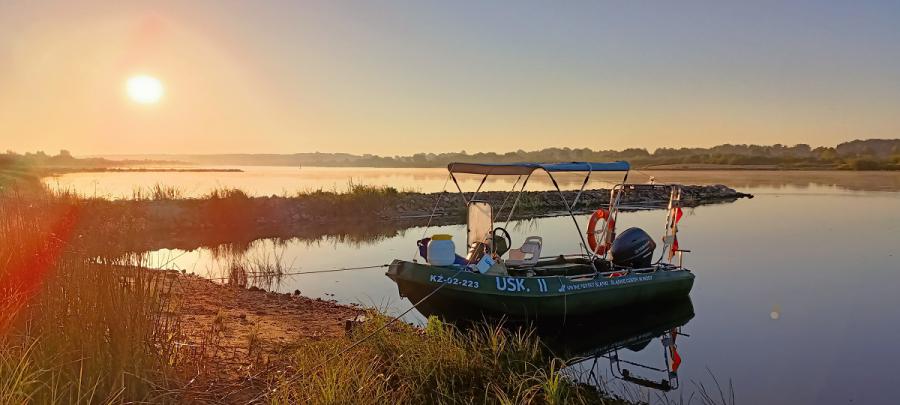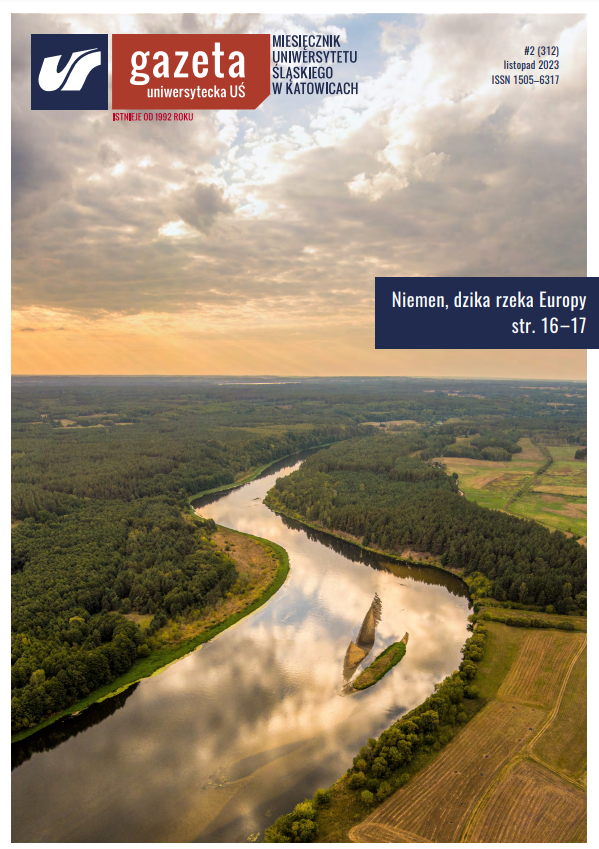| Małgorzata Kłoskowicz, PhD |
‘The Neman has surprised me. No longer than a year ago, I was convinced that the last wild river in Europe was the Vistula. I could not be more wrong. The Neman is far wilder with all its picturesque meanders, irregular banks and mountain-like ‘personality’, which we have been experiencing while travelling down the river from the town of Druskininkai to the town of Rusnė in the Neman Delta,’ says Andrzej Woźnica, PhD, DSc, Assoc. Prof., the Director of the USil Silesian Water Centre and the leader of the expedition, with the goal of complex research of water quality of the biggest Lithuanian river. The research carried out by the Polish-Lithuanian-Italian team will be the next step in developing recommendations for other European rivers to improve their water stage and quality.
It all started with the Vistula. In July 2021, the Silesian Water Centre and the ‘Why Not’ Foundation completed the project ‘Clean Vistula? Why Not’; it was a journey from the source of the biggest Polish river to its mouth, carried out to collect and analyse as much data as possible. The findings were not optimistic due to the river’s high salinity. Similar research started a year later. This time on the Oder, and as it turned out, it was nearly on the eve of the environmental disaster. The expedition was planned to take 10 days, it started in Ostrava and finished in Szczecin Lagoon. The research was meant to compare the water quality of both rivers. It has eventually become critical evidence to understand what in fact caused the disaster and the mass fish deaths on the Oder.
‘Although the analyses are still being carried out, I think I may already say that the results will allow us to deal with the aftermaths of such incidents better. We cannot prevent them, but I hope that we will turn our results into specific recommendations that might perhaps decrease the likelihood of such incidents occurring,’ says Prof. Andrzej Woźnica.
The scientists had two big expeditions behind them and a reliable research method. Their plans reached another river, this time beyond the borders of Poland: the Neman. ‘The plan became a reality thanks to the collaboration with the universities of the Transform4Europe Alliance we are a member of. Naturally, we got in touch with scientists from Vytautas Magnus University in Kaunas first. After all, we wanted to examine the biggest Lithuanian river. They have indicated places for measurements and the river sections where the biggest problems are noticed. Eventually, we have collected samples from 17 points in the river; where it was possible, we also carried out analyses of water flow and analyses in the sampling points using multispectral cameras mounted on drones,’ explains Prof. Andrzej Woźnica

The research team, from the left: Raimundas Baublys, PhD (Vytautas Magnus University in Kaunas); Marcin Lipowczan, PhD; Andrzej Woźnica, PhD, DSc; Weronika Walkowiak, 2nd-grade student in Aquamatics (USil) | Photo by Weronika Walkowiak
‘The samples we have collected made it to laboratories of Vytautas Magnus University in Kaunas and the University of Trieste,’ he adds.
The expedition started in September 2023 and took four days. USKA II Research Ship was manned by people from the USil Faculty of Natural Sciences: Prof. Andrzej Woźnica, Marcin Lipowczan, PhD, and Weronika Walkowiak, a student in Aquamatics. They were supported from land by Raimundas Baublys, PhD, from Vytautas Magnus University in Kaunas. The drone was operated by Egidijus Kasiulis, PhD, and Linas Jurevičius, PhD, (Vytautas Magnus University), whereas the samples will be analysed by Chiara Manfrin, PhD, and Prof. Giovanni Bacaro from the University of Trieste.
‘We wanted to examine the waters of the Neman from its source to its mouth, just like in the case of the Vistula and the Oder. Unfortunately, our plans were thwarted by the political situation, and we had to start the expedition from Druskininkai in Lithuania. The Neman has its source in Belarus; naturally, there was no possibility of starting collecting samples from there,’ explains Prof. Andrzej Woźnica.
As he says, the expedition ended in Rusnė in the Neman Delta, several kilometres away from the river’s mouth in the Curonian Lagoon. ‘For the last dozens of kilometres, we travelled along the Lithuania-Russia border (Kaliningrad Oblast), supported by the Lithuanian border guards, whom we are grateful. Special thanks go to Nereta and Tomas, who selflessly helped us when our boat trailer broke down.’
The scientists collected samples at the Neman’s vital points. Although from the scientific point of view they lack any information about the water quality along the section from the source to the Belarus-Lithuania border, they underline that they have gathered quite some interesting research material.
The venture aimed at complex research of the Neman’s water quality, including over a dozen physicochemical and hydrobiological parameters.
‘We still have to wait for the results. For now, I can only say that the Neman has surprised me. No longer than a year ago, I was convinced that the last wild river in Europe was the Vistula. I could not be more wrong. The Neman is far wilder with all its picturesque meanders, irregular banks and mountain-like ‘personality’, which we have been experiencing while travelling down the river from the town of Druskininkai to the town of Rusnė in the Neman Delta,’ says Prof. Andrzej Woźnica.
Although the river has hydro-technical infrastructure and many sections in the lower course are regulated, the scientist says that neither on the Oder nor the Vistula has the expedition encountered such meanders.

Morning view by the camp in Jurbork | Photo by Weronika Walkowiak
The scientists drew their attention to the small amount of water in the river. They had faced this problem on the Vistula and the Oder as well. The shallows and sandbanks posed quite a challenge to the research boat. Moreover, since the Neman flows along post-glacial areas, it sometimes resembles a raging mountain river with boulders at the bottom. Although the section from Druskininkai to Kaunas was not the easiest one, all the hardships were compensated by the breathtaking views. It is not only the picturesque meanders but also vast forested areas and greenery submerged in what turns out to be a clean river without much evident human impact, unlike the Vistula and the Oder.
The river seemed to change from Kaunas onwards and was becoming more ‘civilised’, as admits Prof. Andrzej Woźnica. A navigable route with a regulated riverbed and hydro-technical infrastructure has certainly made the expedition easier. Nevertheless, the journey cannot be labelled as uneventful, especially in its first stage.
‘Despite our experience from the Vistula and the Oder, we somehow managed to lose two bolts. Sometimes the river suddenly became shallow and we could but to push the boat through stretches of sand and gravel. Such surprises are nothing extraordinary during any expedition, and although we are well-prepared, there is always something that may catch us off guard. And it was no different this time,’ admits the biologist.
‘Here, I would like to thank our Lithuanian friends. Especially Raimundas Baublys, PhD. It did not matter whether we were out of fuel or a crane arm snapped, we could always count on him. I would also like to thank the employees of the Lithuanian Border Guards who saved us at the very end of the expedition when we had a critical failure of our equipment,’ adds the University of Silesia’s scientist.
Samples of water and sediments, along with other collected data, have already been delivered to laboratories and are waiting for a thorough analysis. Although it is too early to draw any conclusions, Prof. Andrzej Woźnica emphasises that the Neman is far better than the Vistula and the Oder in terms of water quality. ‘These are three totally different rivers: almost entirely saline Oder, partly saline Vistula, and nearly devoid of salinity Neman, having the lowest level of anthropogenic environmental impact out of them.’
Although the analyses are still being carried out, the scientists plan their next international projects.
‘We will not study another European river this time. We want to focus on the comparable analysis of the data we were collecting during the last three years. Based on that, we wish to create a set of recommendations regarding river management to improve their quality while maintaining the function they play,’ sums up the Director of the Silesian Water Centre.
The project under the name ‘Stronger Together – Strategic partnerships of the University of Silesia in Katowice within the Transform4Europe network’ was financed by the Polish National Agency for Academic Exchange.
The article The Neman, a wild river of Europe was published in November issue No. 2 (312) of the University of Silesia Magazine.






